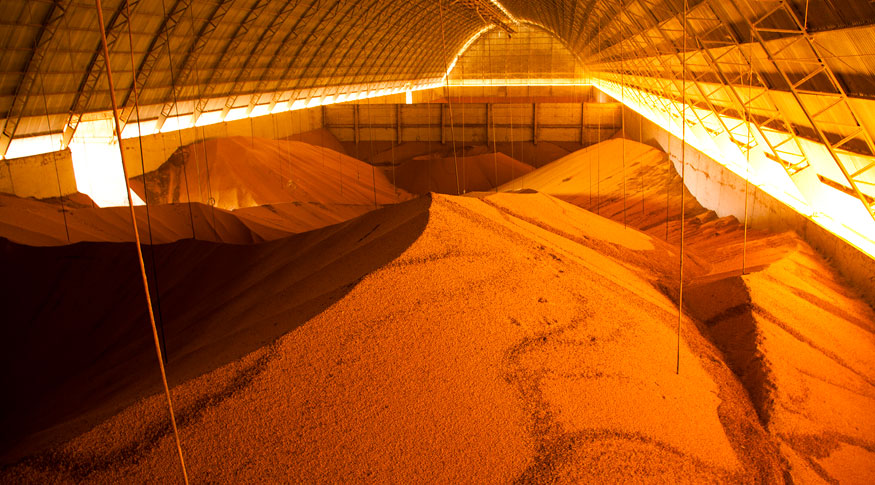Agriculture
IBGE estimates a drop of 1% in 2020 grain crop
November 13, 2019 09h00 AM | Last Updated: November 18, 2019 01h22 PM

The national grain crops should be of 238.5 million tonnes in 2020, according to the first forecast from the Systematic Survey of Agricultural Production, released today by the IBGE. It represents a reduction of 1% in relation to the 2019 crop forecast, a difference of 2.3 million tonnes. Despite the fall, this is the second largest estimate in the IBGE’s time series that started in 1975, just behind 2017 (240.6 millions).
The reduction is especially due to the lower production expected for corn (-7.5%), while for soybeans a growth of 4.7% is expected. The first forecast of corn is a production of 92.7 million tonnes in the next year, which represents a reduction of 7.5 million tonnes in relation to 2019. The survey keeps the trend of a higher volume of corn 2nd crop production, with 72.4% of participation in the national production for 2020, against 27.6% of the corn 1st crop participation.
For the IBGE researcher, Mr. Carlos Barrradas, the scenario is not so favorable for corn 2nd crop in 2020 as it was in 2019. “The agricultural year started normally, with the soybeans planting being carried out mostly in the second fortnight of October; therefore, the planting window for corn 2nd crop should be more restricted”, he said.
The soybean production should increase 4.7% in 2020, reaching 118.4 million tonnes. The area that will be planted with the grain should be of 36 million hectares, a 0.7% rise. Among the biggest producers, Mato Grosso estimates to reap 31.4 million tonnes, a decline of 2.4% in relation to 2019, despite the increase of 0.4% in the planting area. Paraná, which is the second biggest producer, expects to produce 19.8 million tonnes, an increase of 22.6%, recovering from the 2019 result, which was compromised by the droughts during crop cycle.
In 2019, crops should hit a new record
The IBGE also released today that the national crop of cereals, legumes and oilseeds should reach a new record of 240.8 million tonnes in 2019, 1% higher than in 2017, with extra 2.4 million tonnes produced. In addition, the result represents a rise of 6.3% comparing to the production last year.
The increase was replicated by corn, which should have a record production of 100.2 million in 2019 (25.9 million tonnes of corn 1st crop and 74.3 million tonnes of corn 2nd crop), which represents a growth of 23.2% against 2018. “There a pricing context that stimulated corn 2nd crop planting. The weather also was convenient”, commented Mr. Barradas.
Another grain that should break the record in the IBGE’s time series is cotton. In this year’s cropt, production should reach 6.9 tonnes, an increase of 39.7% compared with last year. According to the IBGE researcher, the rise in the grain cultivation is due to price improvement.
In contrast, soybeans and rice, two other key grains in the national agricultural production, reduced their crops. The IBGE estimate indicates a production of 113 million tonnes of soybeans in 2019, which represents a retraction of 4.1% comparing to last year. Rice production dropped due to the reduction of 9.5% in the planting area and 12% in the harvested area. A production of 10.3 million tonnes for the grain is estimated, a decrease of 12% in relation to last year.
“Prices have not been encouraging rice consumption in some areas. Producers have been choosing to use the area to cultivate other crops, such as soybeans, for example”, explained Mr. Carlos Barradas.
The survey estimates that, in 2019, the area to be harvested will be of 63.1 million hectares, representing an increase of 3.6% against the harvested area in 2018, a growth of 2.2 million hectares. In relation to the previous month, the estimate of the area to be harvested showed a rise of 71.2 thousand hectares (0.1%). The last record of production was in 2017, when 238.4 million tonnes were produced.
Stocking capacity grows 3.5%
The Survey of Stocks, also released today by the IBGE, showed that the total of the storage capacity available increased 3.5% in the first semester of 2019, against the second semester of 2018, a total of 175.5 million tonnes.
In terms of storage capacity, silos predominate in the country with 84.7 million tonnes, which represents 48.3% of the national storage. Automated and bulk warehouses correspond to 66.7 million tonnes, while conventional, structural and inflatable warehouses are equivalent to 24 million tonnes of the storage capacity.




















